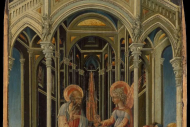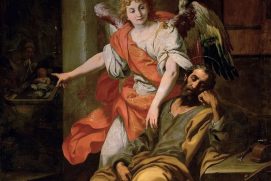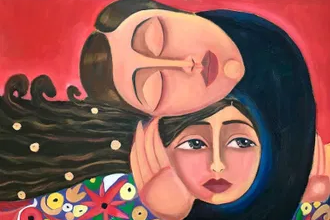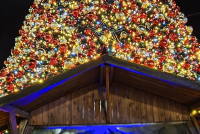Gospel in Art: He must increase, but I must decrease
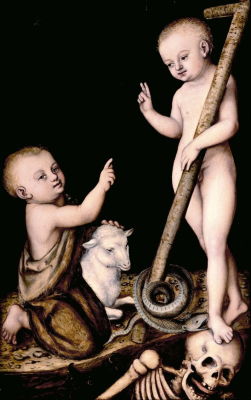
Adoration of the Child Jesus by St John the Baptist, by Lucas Cranach the Elder, 1535 © Museo Lázaro Galdiano, Madrid
Source: Christian Art
Gospel of 11 January 2025
John 3:22-30
At that time: Jesus and his disciples went into the Judean countryside, and he remained there with them and was baptising. John also was baptising at Aenon near Salim, because water was plentiful there, and people were coming and being baptised for John had not yet been put in prison.
Now a discussion arose between some of John's disciples and a Jew over purification. And they came to John and said to him, 'Rabbi, he who was with you across the Jordan, to whom you bore witness - look, he is baptising, and all are going to him.' John answered, 'A person cannot receive even one thing unless it is given him from heaven. You yourselves bear me witness, that I said, "I am not the Christ, but I have been sent before him." The one who has the bride is the bridegroom. The friend of the bridegroom, who stands and hears him, rejoices greatly at the bridegroom's voice. Therefore this joy of mine is now complete. He must increase, but I must decrease.'
Reflection on the painting
Today's Gospel reading concludes with the poignant final words of John the Baptist: 'He must increase, but I must decrease.' After this, John is imprisoned and eventually beheaded, sealing his martyrdom. He recognised that his mission was nearing completion and that the ministry of Jesus, now beginning in earnest, was to take centre stage. These words reflect John's profound humility, as he willingly decreased in significance to exalt Christ. It was a moment of transition, with the ministries of John and Jesus briefly overlapping.
Throughout Scripture, Jesus is referred to by many names, with perhaps the most frequently used being Lord. In the New Testament alone, the term Lord appears 3,322 times. According to the Oxford English Dictionary, a lord is 'a person who has authority, control, or power; a master, chief, or ruler.' By accepting Jesus as Lord of our lives, we allow Him to take charge, to become greater; our egos on the other hand must decrease. Hence John the baptist's words should be spoken by us all: Christ must increase, but I must decrease.
The painting accompanying today's reflection is by Lucas Cranach the Elder, one of the foremost German artists of the 16th century. Cranach was a close friend of Martin Luther (1483-1546) and became the leading visual propagandist of the Protestant Reformation. Known as Pictor celerrimus ('swiftest of painters'), his contemporaries marvelled at the speed with which he produced his works. Hard to believe, seen there is so much detail in his paintings. In our painting, we see John the Baptist clothed in a camel-hair garment, tenderly stroking a lamb while kneeling before the Christ Child. John is pointing directly at Christ. Christ is the one we should follow. The Child holds a cross emerging from a snake, the symbol of original sin. The snake is poised to bite Christ's left foot, which in turn rests on a human skeleton. This imagery aligns closely with Lutheran theology: Martin Luther taught that humanity inherits Adamic guilt and exists in a state of sin from the moment of conception. Cranach's painting thus communicates profound theology while illustrating the humility and joy of John the Baptist in the presence of Christ.
LINKS
Gospel in Art: https://christian.art/
Today's Reflection: https://christian.art/daily-gospel-reading/john-3-22-30-2025/




